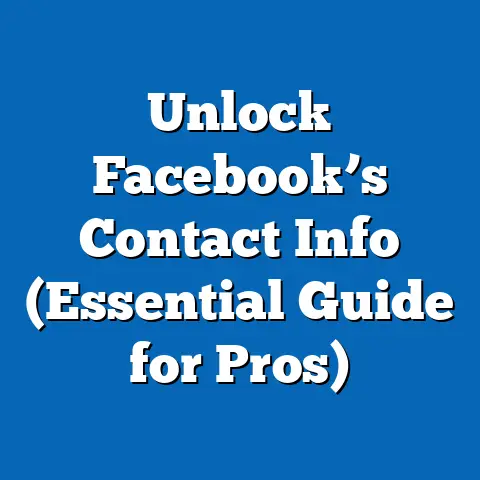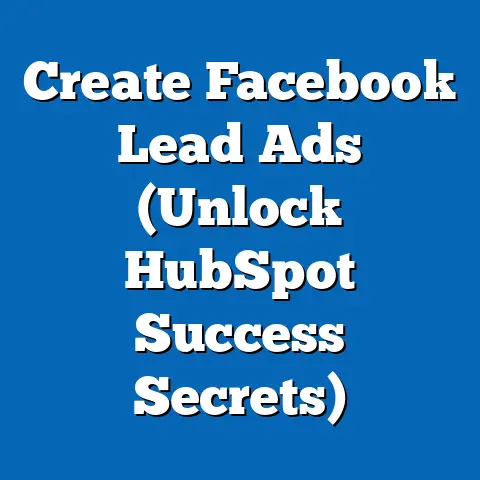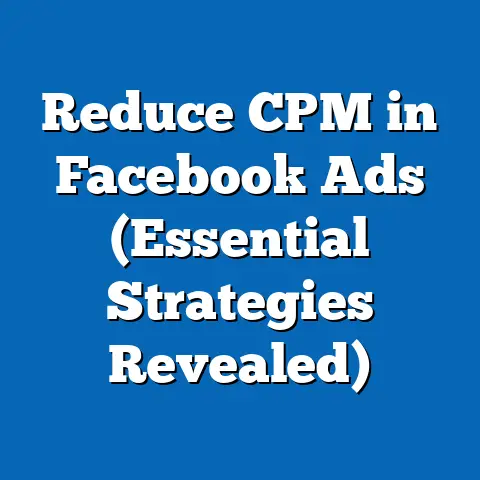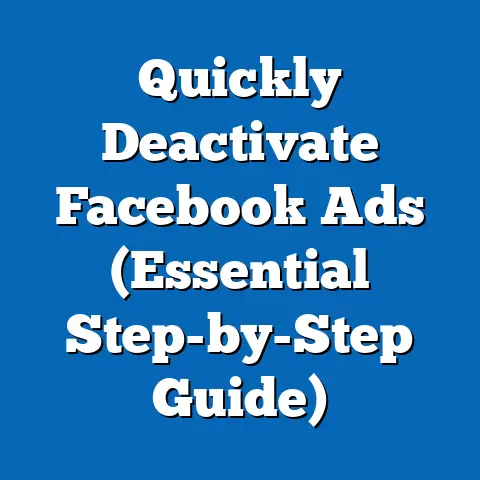Transforming fb ad Previews for Maximum Impact (Expert Tips)
As a digital marketer with years of experience, I’ve learned that capturing attention in the digital space is a constant challenge. But when you’re targeting children on Facebook, the game changes entirely. Their attention spans are shorter than ever, and they’re digital natives, often more tech-savvy than we give them credit for. Over the years, I’ve seen firsthand how a seemingly small detail, like the ad preview, can make or break a campaign.
Think of it like this: you’re walking through a vibrant toy store. What catches your eye first? It’s the colorful packaging, the playful characters, the promise of fun leaping out at you. Facebook ad previews are essentially the digital equivalent of that eye-catching toy packaging. They’re the first impression, the hook that draws children in and makes them want to learn more.
But here’s the rub: you can’t just repurpose your adult-focused ads and expect them to work on kids. You need a completely different approach, one that speaks to their unique interests, understands their world, and respects their developing minds. This is where the art and science of crafting effective Facebook ad previews for children come into play.
Section 1: Understanding the Child Audience
Before you even think about crafting an ad, you need to truly understand your audience. And when that audience is children, that understanding needs to be even more nuanced. It’s not enough to know their age range; you need to delve into their interests, preferences, and how they interact with digital content.
Children are not just miniature adults; they have distinct cognitive and emotional needs. Their brains are still developing, and they perceive the world differently. They’re drawn to bright colors, simple shapes, and engaging characters. They’re also incredibly perceptive and can spot inauthenticity a mile away.
Key Characteristics of Children as Consumers:
- Short Attention Spans: This is a big one. You have mere seconds to capture their attention, so your ad preview needs to be instantly captivating.
- Visual Learners: Children are highly visual. Images and videos are far more effective than text-heavy ads.
- Brand Loyalty: Once a child connects with a brand or character, they tend to be fiercely loyal.
- Influenceable: While they have their own preferences, children are also heavily influenced by their peers, celebrities, and online personalities.
- Digital Savvy: Don’t underestimate their tech skills! Children are often very comfortable navigating digital platforms and can quickly identify ads that feel out of place or irrelevant.
The Role of Parental Influence:
It’s crucial to remember that children are rarely the sole decision-makers when it comes to purchases. Parents often hold the purse strings and have significant influence over what their children consume. Therefore, your ad preview needs to appeal to both the child and the parent.
Think about it: a child might be drawn to a brightly colored toy, but the parent will also consider factors like safety, educational value, and price. Your ad preview can subtly address these concerns by highlighting key features that appeal to parents, such as:
- Educational Benefits: Does the product help children learn new skills or develop their creativity?
- Safety Standards: Is the product made with safe materials and designed to meet safety regulations?
- Positive Reviews: Are there testimonials from other parents who have had positive experiences with the product?
Age-Appropriate Messaging and Visuals:
This is non-negotiable. Your ad preview must be age-appropriate in terms of both content and tone. Avoid anything that could be considered offensive, exploitative, or harmful to children.
Here are a few guidelines to follow:
- Avoid Sexist Stereotypes: Be mindful of gender stereotypes and ensure that your ads are inclusive and representative of all children.
- Promote Healthy Lifestyles: Avoid promoting unhealthy eating habits or sedentary behavior.
- Be Respectful of Diversity: Celebrate diversity in terms of race, ethnicity, culture, and ability.
- Use Simple Language: Keep your ad copy clear and concise, using language that children can easily understand.
- Avoid Overly Commercial Messages: Children are more likely to respond to ads that feel authentic and genuine.
My Personal Experience:
I once worked on a campaign for a children’s educational app. Initially, we focused solely on the app’s features and benefits, using language that was more geared towards parents. The results were disappointing. It wasn’t until we shifted our focus to the child’s perspective, highlighting the fun and engaging aspects of the app, that we started to see a significant increase in engagement. We used brighter colors, incorporated playful animations, and wrote ad copy that spoke directly to children’s curiosity. The lesson I learned was that understanding your audience is paramount, and when that audience is children, you need to put yourself in their shoes and see the world through their eyes.
Key Takeaway:
- To effectively target children with Facebook ads, it’s crucial to understand their unique characteristics, the role of parental influence, and the importance of age-appropriate messaging and visuals.
Next Steps:
- Research your target age group to understand their current interests and trends.
- Consider how parents might perceive your product and incorporate their concerns into your ad strategy.
- Review your existing ad copy and visuals to ensure they are age-appropriate and inclusive.
Section 2: The Anatomy of Facebook Ad Previews
Now that we have a solid understanding of our audience, let’s dissect the anatomy of a Facebook ad preview. This is where the rubber meets the road, where you transform that understanding into a compelling visual and textual message that grabs children’s attention.
A Facebook ad preview typically consists of four key components:
- Image/Video: The visual centerpiece of your ad.
- Headline: The attention-grabbing title that introduces your product or service.
- Description: The brief text that provides more details and entices children to learn more.
- Call-to-Action (CTA): The button or text that prompts children to take a specific action, such as “Learn More” or “Play Now.”
Tailoring Each Component for Children:
Each of these components needs to be carefully tailored to appeal to children’s interests and preferences. Here’s how:
1. Image/Video:
- Use Bright Colors: Children are naturally drawn to bright, vibrant colors. Use a color palette that is cheerful and playful.
- Incorporate Engaging Characters: If you have a mascot or character associated with your brand, feature it prominently in your ad preview.
- Show Children Using the Product: Seeing other children enjoying your product can be a powerful motivator.
- Use Animation: Animated videos are particularly effective at capturing children’s attention.
- Keep it Simple: Avoid cluttered or confusing visuals. Focus on one or two key elements that will resonate with children.
2. Headline:
- Use Simple Language: Keep your headline short, sweet, and easy to understand.
- Highlight the Benefit: Focus on what children will gain from using your product or service.
- Ask a Question: A well-crafted question can pique children’s curiosity and encourage them to learn more.
- Use Action Words: Use verbs that are exciting and engaging, such as “Discover,” “Explore,” or “Create.”
- Keep it Relevant: Make sure your headline is directly relevant to the image or video.
3. Description:
- Tell a Story: Children love stories. Use your description to create a mini-narrative that captivates their imagination.
- Focus on Fun: Emphasize the fun and excitement that your product or service offers.
- Use Descriptive Language: Paint a vivid picture with your words, using sensory details that appeal to children’s imagination.
- Keep it Concise: Children have short attention spans, so keep your description brief and to the point.
- Highlight Key Features: Briefly mention the key features of your product or service that will appeal to children and their parents.
4. Call-to-Action (CTA):
- Use Clear and Concise Language: Make it easy for children to understand what you want them to do.
- Use Action Words: Use verbs that encourage action, such as “Play Now,” “Learn More,” or “Get Started.”
- Make it Visually Appealing: Use a button that is brightly colored and easy to see.
- Keep it Age-Appropriate: Ensure that the CTA is appropriate for the age of your target audience.
- Test Different CTAs: Experiment with different CTAs to see which ones perform best.
Examples of Effective Ad Previews for Children:
- A video game ad featuring a short clip of gameplay with a headline that says, “Explore a World of Adventure!” and a CTA that says, “Play Now.”
- A children’s book ad featuring a colorful illustration from the book with a headline that says, “Discover a Magical Story!” and a CTA that says, “Learn More.”
- An educational app ad featuring a child using the app with a headline that says, “Learn and Play at the Same Time!” and a CTA that says, “Get Started.”
The Significance of Visual Elements:
Visual elements play a crucial role in capturing children’s attention. Colors, characters, and animations can all have a significant impact on how children perceive your ad.
- Colors: Use a color palette that is cheerful and playful. Bright colors like red, yellow, and blue tend to be particularly appealing to children.
- Characters: If you have a mascot or character associated with your brand, feature it prominently in your ad preview. Children often form strong attachments to characters and are more likely to engage with ads that feature them.
- Animations: Animated videos are particularly effective at capturing children’s attention. Use animation to bring your characters to life and create a more engaging experience.
My Personal Experience:
I remember working on a campaign for a children’s clothing brand. Initially, we used static images of children wearing the clothes. The results were mediocre. It wasn’t until we switched to using short animated videos featuring the clothes that we started to see a significant increase in engagement. The videos showed children playing and having fun while wearing the clothes, which resonated with both children and their parents. The lesson I learned was that visual elements can make a huge difference in the effectiveness of your ad previews, especially when targeting children.
Key Takeaway:
- A Facebook ad preview consists of four key components: image/video, headline, description, and call-to-action. Each component needs to be carefully tailored to appeal to children’s interests and preferences.
Next Steps:
- Review your existing ad previews and identify areas where you can improve the visual elements, headline, description, and CTA.
- Experiment with different color palettes, characters, and animations to see what resonates best with your target audience.
- Test different headlines, descriptions, and CTAs to see which ones generate the most engagement.
Section 3: Crafting Eye-Catching Visuals
Visuals are the heart and soul of any successful Facebook ad aimed at children. They’re the first thing children see, and they play a critical role in capturing their attention and conveying your message. But creating visuals that truly resonate with children requires more than just throwing together some bright colors and cute characters. It requires a deep understanding of their visual preferences, their emotional needs, and the psychological impact of different design elements.
Expert Tips for Creating Engaging Visuals:
- Embrace Bright, Bold Colors: As mentioned before, children are naturally drawn to vibrant colors. Don’t be afraid to use a bold color palette that pops off the screen. Think primary colors like red, yellow, and blue, as well as secondary colors like green, orange, and purple.
- Feature Beloved Characters: If your brand has a mascot or character, make it the star of your ad. Children often form strong attachments to characters and are more likely to engage with ads that feature them. If you don’t have a character, consider licensing one from a popular children’s show or movie.
- Use Relatable Scenarios: Show children using your product or service in a way that is relatable and relevant to their lives. For example, if you’re advertising a children’s book, show children reading the book in a cozy setting.
- Incorporate Playful Designs: Use design elements that are fun and playful, such as whimsical fonts, cartoonish illustrations, and quirky animations.
- Keep it Simple and Uncluttered: Avoid overwhelming children with too much information or too many visual elements. Focus on one or two key messages and keep the design clean and simple.
- Use High-Quality Images and Videos: Make sure your visuals are crisp, clear, and well-produced. Low-quality images or videos can be a turnoff for children.
- Consider the Platform: Optimize your visuals for the specific platform you’re using. For example, Facebook ads should be visually appealing on both desktop and mobile devices.
The Psychological Impact of Colors and Shapes:
Colors and shapes can have a profound impact on children’s emotions and behavior. Understanding these psychological effects can help you create more effective visuals.
- Red: Excitement, energy, passion
- Yellow: Happiness, optimism, cheerfulness
- Blue: Calmness, trust, security
- Green: Nature, growth, health
- Orange: Enthusiasm, creativity, fun
- Purple: Royalty, magic, imagination
Shapes can also evoke different emotions:
- Circles: Harmony, unity, completeness
- Squares: Stability, structure, order
- Triangles: Energy, excitement, action
Examples of Successful Campaigns with Unique Visual Strategies:
- Lego: Lego consistently uses vibrant visuals that showcase the endless possibilities of their building blocks. Their ads often feature children creating imaginative structures and scenarios, which appeals to children’s creativity and problem-solving skills.
- Disney: Disney is a master of visual storytelling. Their ads often feature beloved characters from their movies and TV shows, and they use animation to bring those characters to life.
- Nickelodeon: Nickelodeon uses bright colors, playful designs, and quirky animations to create visuals that are instantly recognizable and appealing to children.
My Personal Experience:
I once worked on a campaign for a children’s toy that was designed to promote STEM learning. Initially, we used visuals that were more focused on the educational aspects of the toy, featuring graphs and charts. The results were underwhelming. It wasn’t until we switched to using visuals that showcased the fun and playful aspects of the toy, featuring children building and experimenting with it, that we started to see a significant increase in engagement. The lesson I learned was that even when you’re promoting something educational, you need to focus on the fun and excitement to capture children’s attention.
Key Takeaway:
- Creating eye-catching visuals for Facebook ad previews requires a deep understanding of children’s visual preferences, emotional needs, and the psychological impact of different design elements.
Next Steps:
- Brainstorm visual concepts that align with your brand and appeal to children’s interests.
- Experiment with different color palettes, shapes, and animations to see what resonates best with your target audience.
- Get feedback from children on your visual concepts before launching your campaign.
Section 4: Writing Compelling Copy
While visuals are crucial for capturing children’s attention, the copy in your Facebook ad preview plays a vital role in conveying your message and encouraging them to take action. But writing copy that resonates with children requires a different approach than writing copy for adults. You need to use language that is simple, clear, and engaging, and you need to focus on the benefits that children will gain from using your product or service.
How to Write Headlines and Descriptions That Speak to Children’s Interests:
- Use Simple Language: Avoid using jargon or complex vocabulary. Keep your language clear and concise, using words that children can easily understand.
- Focus on the Benefits: Instead of focusing on the features of your product or service, focus on the benefits that children will gain from using it. For example, instead of saying “Our app has 100 educational games,” say “Learn and have fun with 100 amazing games!”
- Ask Questions: A well-crafted question can pique children’s curiosity and encourage them to learn more. For example, “Want to explore a magical world?”
- Use Action Words: Use verbs that are exciting and engaging, such as “Discover,” “Explore,” or “Create.”
- Keep it Short and Sweet: Children have short attention spans, so keep your headlines and descriptions brief and to the point.
The Importance of Storytelling:
Children love stories. Incorporating a narrative into your ad copy can be a powerful way to capture their imagination and make your message more memorable.
- Create a Mini-Narrative: Use your description to create a short story that captivates children’s imagination. For example, “Join [Character Name] on an exciting adventure to [Location]!”
- Use Sensory Details: Paint a vivid picture with your words, using sensory details that appeal to children’s imagination. For example, “Imagine the taste of sweet, juicy strawberries!”
- Make it Relatable: Create a story that is relatable to children’s lives and experiences. For example, “Have you ever felt nervous about starting a new school? [Character Name] did too!”
Techniques for Creating Clear, Concise, and Engaging CTAs:
Your call-to-action (CTA) is the final step in your ad preview. It’s the prompt that encourages children to take a specific action, such as “Learn More” or “Play Now.”
- Use Clear and Concise Language: Make it easy for children to understand what you want them to do.
- Use Action Words: Use verbs that encourage action, such as “Play Now,” “Learn More,” or “Get Started.”
- Make it Visually Appealing: Use a button that is brightly colored and easy to see.
- Keep it Age-Appropriate: Ensure that the CTA is appropriate for the age of your target audience.
- Test Different CTAs: Experiment with different CTAs to see which ones perform best.
Examples of Effective Ad Copy Aimed at Children:
- Video Game Ad: Headline: “Explore a World of Adventure!” Description: “Join [Character Name] on an epic quest to save the kingdom! Play now and discover amazing treasures!” CTA: “Play Now”
- Children’s Book Ad: Headline: “Discover a Magical Story!” Description: “Read about [Character Name]’s incredible adventure in a land filled with talking animals and enchanted forests! Get your copy today!” CTA: “Learn More”
- Educational App Ad: Headline: “Learn and Play at the Same Time!” Description: “Our app makes learning fun! Play hundreds of educational games and earn rewards! Download now and get a free trial!” CTA: “Get Started”
My Personal Experience:
I once worked on a campaign for a children’s museum. Initially, we used ad copy that was more focused on the educational aspects of the museum, highlighting the exhibits and learning opportunities. The results were mediocre. It wasn’t until we switched to using ad copy that focused on the fun and excitement of visiting the museum, telling stories about the adventures children could have there, that we started to see a significant increase in engagement. The lesson I learned was that storytelling can be a powerful tool for capturing children’s attention and encouraging them to take action.
Key Takeaway:
- Writing compelling copy for Facebook ad previews requires using simple language, focusing on the benefits, incorporating storytelling, and creating clear, concise, and engaging CTAs.
Next Steps:
- Brainstorm ad copy ideas that align with your brand and appeal to children’s interests.
- Experiment with different headlines, descriptions, and CTAs to see which ones resonate best with your target audience.
- Get feedback from children on your ad copy before launching your campaign.
Section 5: Testing and Analyzing Ad Previews
Creating effective Facebook ad previews for children is not a one-time task; it’s an ongoing process of testing, analyzing, and refining. What works today might not work tomorrow, so it’s crucial to continuously monitor your ad performance and make adjustments as needed.
The Significance of A/B Testing:
A/B testing, also known as split testing, is a powerful technique for optimizing your ad previews. It involves creating two or more versions of your ad, each with a slight variation, and then showing them to different segments of your audience. By comparing the performance of each version, you can identify which elements are most effective at capturing children’s attention and driving results.
Here are some elements you can A/B test:
- Visuals: Test different images, videos, and animations.
- Headlines: Test different headlines to see which ones are most attention-grabbing.
- Descriptions: Test different descriptions to see which ones are most engaging.
- CTAs: Test different CTAs to see which ones generate the most clicks.
- Targeting: Test different targeting options to see which audiences are most responsive to your ads.
Metrics to Track for Success:
To effectively analyze your ad performance, you need to track the right metrics. Here are some key metrics to monitor:
- Engagement Rate: This measures how much children are interacting with your ads. It includes metrics like likes, comments, shares, and saves.
- Click-Through Rate (CTR): This measures the percentage of children who click on your ad after seeing it.
- Conversion Rate: This measures the percentage of children who take a desired action after clicking on your ad, such as making a purchase or downloading an app.
- Cost Per Click (CPC): This measures the average cost you pay each time someone clicks on your ad.
- Cost Per Conversion (CPC): This measures the average cost you pay for each conversion.
- Reach: The number of unique individuals who saw your ad.
- Frequency: The average number of times each person saw your ad.
- Relevance Score: Facebook’s assessment of how relevant your ad is to your target audience.
Strategies for Analyzing Data:
Once you’ve collected data on your ad performance, you need to analyze it to identify trends and insights. Here are some strategies for analyzing your data:
- Compare A/B Test Results: Analyze the results of your A/B tests to identify which versions of your ad performed best.
- Identify High-Performing Ads: Identify the ads that are generating the most engagement, clicks, and conversions.
- Identify Low-Performing Ads: Identify the ads that are underperforming and determine why.
- Segment Your Data: Segment your data by age, gender, location, and other demographic factors to identify trends and patterns.
- Use Visualizations: Use charts and graphs to visualize your data and make it easier to understand.
My Personal Experience:
I once worked on a campaign for a children’s clothing brand. We were running several different ads, but we noticed that one ad was significantly outperforming the others. After analyzing the data, we discovered that the high-performing ad featured a video of children playing and having fun while wearing the clothes. This insight led us to create more videos that showcased the fun and playful aspects of the clothing, which resulted in a significant increase in overall campaign performance. The lesson I learned was that data analysis can provide valuable insights that can help you optimize your ad campaigns and drive results.
Key Takeaway:
- Testing and analyzing ad previews is an ongoing process that involves A/B testing, tracking key metrics, and analyzing data to identify trends and insights.
Next Steps:
- Implement A/B testing to optimize your ad previews.
- Track key metrics to monitor your ad performance.
- Analyze your data to identify trends and insights.
- Continuously refine your ad previews based on your findings.
Section 6: Case Studies and Success Stories
Learning from the experiences of others can be a valuable way to improve your own Facebook advertising strategies. In this section, we’ll explore case studies of brands that have successfully transformed their Facebook ad previews to engage children, analyzing the strategies they employed and the results they achieved.
Case Study 1: Lego
Lego is a master of creating engaging Facebook ads that appeal to children’s creativity and imagination. Their ads often feature vibrant visuals that showcase the endless possibilities of their building blocks, and they use ad copy that encourages children to explore their creativity and build amazing creations.
Strategy:
- Vibrant Visuals: Lego uses bright colors and playful designs to create visuals that are visually appealing to children.
- Showcase Possibilities: Their ads often feature children creating imaginative structures and scenarios, which appeals to children’s creativity and problem-solving skills.
- Encourage Creativity: Their ad copy encourages children to explore their creativity and build amazing creations.
Results:
- High engagement rates
- Increased brand awareness
- Increased sales
Key Takeaway:
- Focus on showcasing the possibilities of your product and encouraging children’s creativity.
Case Study 2: Disney
Disney is a master of visual storytelling, and their Facebook ads are no exception. Their ads often feature beloved characters from their movies and TV shows, and they use animation to bring those characters to life.
Strategy:
- Feature Beloved Characters: Disney’s ads often feature beloved characters from their movies and TV shows.
- Use Animation: They use animation to bring those characters to life and create a more engaging experience.
- Tell Stories: Their ads often tell short stories that capture children’s imagination.
Results:
- High engagement rates
- Increased brand loyalty
- Increased ticket sales
Key Takeaway:
- Leverage the power of storytelling and feature beloved characters in your ads.
Case Study 3: Nickelodeon
Nickelodeon is known for its bright colors, playful designs, and quirky animations, and their Facebook ads reflect this brand identity. Their ads are instantly recognizable and appealing to children.
Strategy:
- Bright Colors: Nickelodeon uses bright colors to create visuals that are visually appealing to children.
- Playful Designs: They use playful designs to create a fun and engaging experience.
- Quirky Animations: Their ads often feature quirky animations that capture children’s attention.
Results:
- High engagement rates
- Increased brand awareness
- Increased viewership
Key Takeaway:
- Create ads that are visually consistent with your brand identity and appeal to children’s sense of humor.
My Personal Experience:
I once worked with a small toy company that was struggling to gain traction on Facebook. After analyzing their existing ads, I realized that they were not leveraging the power of visual storytelling. I encouraged them to create a series of short animated videos that showcased the fun and playful aspects of their toys. The videos were a huge success, generating high engagement rates and driving a significant increase in sales. The lesson I learned was that even small businesses can achieve great results by focusing on creating engaging and visually appealing ads that tell a story.
Key Takeaway:
- Learning from the experiences of others can be a valuable way to improve your own Facebook advertising strategies.
Next Steps:
- Research successful Facebook ad campaigns in your industry.
- Analyze the strategies they employed and the results they achieved.
- Identify lessons learned and key takeaways that can be applied to your own campaigns.
Conclusion
Crafting effective Facebook ad previews for children is a unique and rewarding challenge. It requires a deep understanding of your audience, a creative approach to visuals and copy, and a commitment to continuous testing and optimization. By following the expert tips outlined in this guide, you can transform your Facebook ad previews into powerful tools for engaging children, building brand loyalty, and driving results.
Remember, children are not just miniature adults. They have distinct cognitive and emotional needs, and they perceive the world differently. To effectively reach them, you need to put yourself in their shoes and see the world through their eyes.
Embrace creativity, understand your audience, and continuously optimize your ads. By doing so, you can create Facebook ads that not only capture children’s attention but also foster positive interactions with your brand.
So, go forth and create ads that inspire, entertain, and educate. The future of your brand may depend on it.






